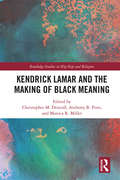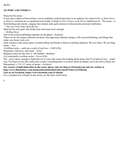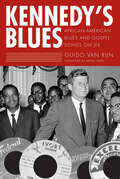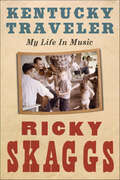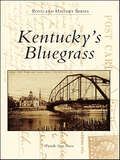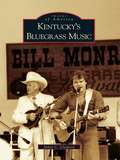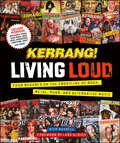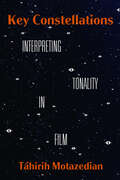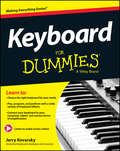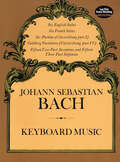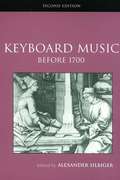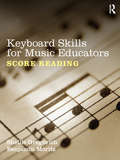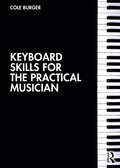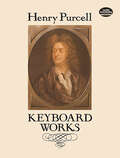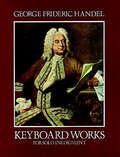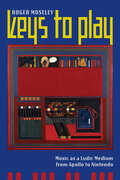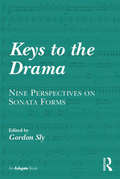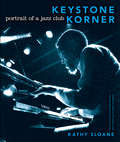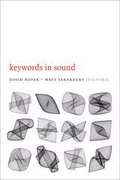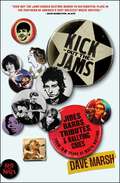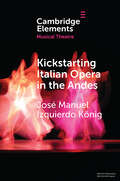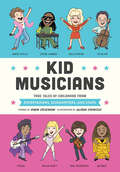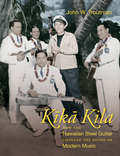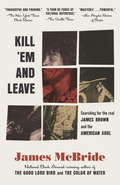- Table View
- List View
Kelly 'n' Me
by Myron LevoyFifteen-year-old Anthony falls for Kelly, the mysterious girl whom he meets singing in Central Park and joins to perform street music all over New York, but their romance is threatened by their very different backgrounds.
Kendrick Lamar and the Making of Black Meaning (Routledge Studies in Hip Hop and Religion)
by Anthony B. Pinn Monica R. Miller Christopher M. DriscollKendrick Lamar has established himself at the forefront of contemporary hip-hop culture. Artistically adventurous and socially conscious, he has been unapologetic in using his art form, rap music, to address issues affecting black lives while also exploring subjects fundamental to the human experience, such as religious belief. This book is the first to provide an interdisciplinary academic analysis of the impact of Lamar’s corpus. In doing so, it highlights how Lamar’s music reflects current tensions that are keenly felt when dealing with the subjects of race, religion and politics. Starting with Section 80 and ending with DAMN., this book deals with each of Lamar’s four major projects in turn. A panel of academics, journalists and hip-hop practitioners show how religion, in particular black spiritualties, take a front-and-center role in his work. They also observe that his astute and biting thoughts on race and culture may come from an African American perspective, but many find something familiar in Lamar’s lyrical testimony across great chasms of social and geographical difference. This sophisticated exploration of one of popular culture’s emerging icons reveals a complex and multi faceted engagement with religion, faith, race, art and culture. As such, it will be vital reading for anyone working in religious, African American and hip-hop studies, as well as scholars of music, media and popular culture.
Kendrick Lamar's To Pimp A Butterfly (33 1/3 Series)
by Sequoia ManerBreaking the global record for streams in a single day, nearly 10 million people around the world tuned in to hear Kendrick Lamar's sophomore album in the hours after its release. To Pimp a Butterfly was widely hailed as an instant classic, garnering laudatory album reviews, many awards, and even a canonized place in Harvard's W. E. B. Du Bois archive. Why did this strangely compelling record stimulate the emotions and imaginations of listeners? <p><p>This book takes a deep dive into the sounds, images, and lyrics of To Pimp a Butterfly to suggest that Kendrick appeals to the psyche of a nation in crisis and embraces the development of a radical political conscience. Kendrick breathes fresh life into the Black musical protest tradition and cultivates a platform for loving resistance. Combining funk, jazz, and spoken word, To Pimp a Butterfly's expansive sonic and lyrical geography brings a high level of innovation to rap music. More importantly, Kendrick's introspective and philosophical songs compel us to believe in a future where, perhaps, we gon' be alright.
Kennedy's Blues: African-American Blues and Gospel Songs on JFK (American Made Music Series)
by Guido van RijnKennedy's Blues: African American Blues and Gospel Songs on JFK collects in a single volume the blues and gospel songs written by African Americans about the presidency of John F. Kennedy and offers a close analysis of Kennedy's hold upon the African-American imagination. These blues and gospel songs have never been transcribed and analyzed in a systematic way, so this volume provides a hitherto untapped source on the perception of one of the most intriguing American presidents. After eight years of Republican rule, the young Democratic president received a warm welcome from African Americans. However, with the Cold War military draft and the slow pace of civil rights measures, inspiration temporarily gave way to impatience. Dr. Martin Luther King, Jr., Medgar Evers, the March on Washington, and the groundbreaking civil rights bill all found their way into blues and gospel songs. The many blues numbers devoted to the assassination and the president's legacy are evidence of JFK's near-canonization by African Americans. Blues historian Guido van Rijn shows that John F. Kennedy became a mythical hero to blues songwriters despite what was left unaccomplished.
Kentucky Traveler: My Life in Music
by Ricky SkaggsIn Kentucky Traveler, Ricky Skaggs, the music legend who revived modern bluegrass music, gives a warm, honest, one-of-a-kind memoir of forty years in music—along with the Ten Commandments of Bluegrass, as handed down by Ricky’s mentor Bill Monroe; the Essential Guide to Bedrock Country Songs, a lovingly compiled walk through the songs that have moved Skaggs the most throughout his life; Songs the Lord Taught Us, a primer on Skaggs’s most essential gospel songs; and a bevy of personal snapshots of his musical heroes.For readers of Johnny Cash’s autobiography, lovers of O Brother Where Art Thou, and fans of country music and bluegrass, Kentucky Traveler is a priceless look at America’s most cherished and vibrant musical tradition through the eyes of someone who has lived it.
Kentucky's Bluegrass (Postcard History Series)
by Wynelle Scott DeeseWithin these pages are vintage postcards, created between 1900 and 1950, that depict an area known across the country as Kentucky�s Bluegrass. From its horse farms to its military forts and river commerce, this seventeen county region exemplifies the spirit and pride of Kentucky, and the images preserved on these postcards bring the history of this unique area to life.
Kentucky's Bluegrass Music
by James C. ClaypoolIt is likely that most fans of bluegrass music would concede that no state should be more associated with bluegrass music than Kentucky--and rightly so. Bluegrass music draws its name from the band that Kentuckian Bill Monroe formed during the late 1930s and 1940s. Bill named his band Bill Monroe and The Blue Grass Boys to honor his home state. Eventually, the music these bands and others like them were playing came to be known as bluegrass music. Later, another Kentuckian, Ebo Walker, while playing with the Bowling Green-based bluegrass band, New Grass Revival, coined the phrase "newgrass" to describe the band's progressive style of music. Other Kentuckians such as Bobby and Sonny Osborne, J. D. Crowe, Ricky Skaggs, and Dale Ann Bradley have become bluegrass stars. Some of the musicians from Kentucky covered in this book are quite famous--some are not. Famous or not, all of them have a deep-rooted passion for the music they play.
Kerrang! Living Loud: Four Decades on the Frontline of Rock, Metal, Punk, and Alternative Music
by Kerrang! Nick RuskellRelive the greatest moments in the last 40 years of hardcore, punk, and metal with this incredible book by Kerrang!, alternative music&’s most trusted publication. Celebrate 40 years of Kerrang! with this year-by-year review of the greatest artists and moments in metal and alternative music. Kerrang! has an unparalleled reputation as one of the world's best-loved rock-focused publications. It continues to be at the forefront of alternative music, flying the flag for metal, hardcore, punk, and beyond, introducing millions to their new favorite bands. Anyone who&’s anyone in the metal scene has featured Kerrang&’s hallowed pages and this unique book chronicles these appearances. If it happened in metal, Kerrang! covered it, as confirmed in this year-by-year survey of alternative music. By highlighting the heaviest albums, the most outlandish stars, the rowdiest mosh pits and the most incredible moments in rock history, fans are going to love it
Key Constellations: Interpreting Tonality in Film (California Studies in Music, Sound, and Media #4)
by Táhirih MotazedianKey is one of the simplest building blocks of music and is among the foundational properties of a work’s musical identity—so why isn’t it a standard parameter in discussing film music? Key Constellations: Interpreting Tonality in Film is the first book to investigate film soundtracks—including original scoring, preexisting music, and sound effects—through the lens of large-scale tonality. Exploring compelling analytical examples from numerous popular films, Táhirih Motazedian shows how key and pitch analysis of film music can reveal hidden layers of narrative meaning, giving readers exciting new ways to engage with their favorite films and soundtracks.
Keyboard For Dummies
by Jerry KovarskyThe easy way to get keyed up on the keyboardWhere Piano For Dummies helps budding musicians to master the black-and-white musical keyboard, Keyboard For Dummies helps them understand the possibilities that unfold when those black-and-whites are connected to state-of-the-art music technology.Keyboard For Dummies explains the ins-and-outs of modern keyboards and helps you get the most out of their capabilities. Key content coverage includes: an overview of the types of keyboards available today and how they differ from acoustic pianos; expert advice on choosing the right keyboard for your wants/needs and how to shop and compare the various models; a close look at the types of sounds an electronic keyboard offers and how to achieve them; step-by-step instruction on how to use keyboards anywhere using external speakers, amps, home stereos, computers, and tablets; guidance on how to use keyboard software and applications to get the most out of keyboard technology; and much more.A multimedia component for this title will be hosted at Dummies.com and includes companion audio tracks that demonstrate techniques and sounds found in the bookStep-by-step instructions make learning keyboard easy and funIntroduces you to the musical possibilities of the keyboardIf you're new to the keyboard or looking to take your skills to the next level, Keyboard For Dummies is a thorough guide to the ins and outs of this popular instrument.
Keyboard Music
by Johann Sebastian BachThe renowned Bach-Gesellschaft, founded in 1850 to collect, edit, and publish all the known works of J. S. Bach, devoted fifty years to its monumental task. It succeeded so well in tracking down Bach's heritage, establishing authenticity, and transcribing accurate texts that it still remains the primary source for Bach's music., Unfortunately, it has always been a fantastically expensive publication, accessible only in the largest libraries.This volume reprints in full, directly from the Bach-Gesellschaft volumes, important keyboard music. It contains the full texts of the Six English Suites, the Six French Suites, Six Partitas from the Clavierübung, the Goldberg Variations, and the Two- and Three-Part Inventions and Sinfonias,The music has been reproduced in large, clear type, directly from the original editions, for maximum clarity. Designed as a playing edition, it will be a necessary book to every performer on the harpsichord or piano, every music student and musicologist, as well as to serious music listeners.
Keyboard Music Before 1700 (Studies In Musical Genres And Repertories)
by Alexander SilbigerKeyboard Music Before 1700 begins with an overview of the development of keyboard music in Europe. Then, individual chapters by noted authorities in the field cover the key composers and repertory before 1700 in England, France, Germany and the Netherlands, Italy, and Spain and Portugal. The book concludes with a chapter on performance practice, which addresses current issues in the interpretation and revival of this music.
Keyboard Skills for Music Educators: Score Reading
by Shellie Gregorich Benjamin MoritzKeyboard Skills for Music Educators: Score Reading is the first textbook equip future educators with the ability to play from an open score at the keyboard. Score reading can be a daunting prospect for even the most accomplished pianist, but it is a skill required of all choral and instrumental music instructors. Although most music education curricula include requirements to achieve a certain level of proficiency in open score reading, standard textbooks contain very little material devoted to developing this skill. This textbook provides a gradual and graded approach, progressing from two-part reading to four or more parts in a variety of clefs. Each chapter focuses on one grouping of voices and provides many musical examples from a broad sampling of choral and instrumental repertoire ranging from Renaissance to contemporary works.
Keyboard Skills for the Practical Musician
by Cole BurgerKeyboard Skills for the Practical Musician provides undergraduate music majors in class piano courses with the techniques and fundamentals they need to flourish into independent, versatile musicians who play with confidence and sensitivity. Organized by skill (rather than level), the topics sequenced in this textbook offer endless flexibility for instructors while guiding students in a step-by-step approach through the development of essential keyboard skills ? such as reading, harmonization, improvisation, and accompaniment ? supporting concepts learned in music theory, ear training, private lessons, methods classes, and ensemble courses. One can draw from many sections of the book in any given class or semester, covering a wide range of piano skills that foster abilities frequently used in a myriad of musical professions.Features: • Over 400 sightreading, transposition, and score reading examples, along with 125 harmonization Melodies• Project assignments that promote independent learning, expose students to new musical styles, and encourage collaboration • A concluding Repertoire section with lists of solo and duet music, 10 ensemble arrangements, 6 duets, and additional pieces from the Baroque, Classical, Romantic, and Post-Romantic eras • Music examples include numerous works by composers from marginalized backgrounds and from global folk music• No prior piano background knowledge neededExplaining the core elements of keyboard learning in an accessible and responsive format while accentuating the importance of learning how to learn, Keyboard Skills for the Practical Musician offers an essential resource for all class piano students and instructors.
Keyboard Works
by Henry PurcellRenowned for the originality of his music and his gifts as a melodist, Henry Purcell (1659-1695) was the preeminent English composer of the seventeenth century and one of the greatest that nation has ever produced. His gifts are apparent not only in the vocal and orchestral works on which his fame rests, but in his delightful keyboard music, much of which is relatively simple and easy to perform. This volume is a near-complete collection of Purcell's keyboard compositions, including the eight suites, the core of his keyboard works. Also included are many miscellaneous one-movement pieces: airs, trumpet tunes (for harpsichord solo), grounds, preludes, dances, etc.Piano students and pianists of intermediate skills will enjoy these pieces for their charm and accessibility. Gathered here in one convenient, inexpensive volume, they offer a treasury of time-honored music that musicians and music lovers will turn to again and again.This volume has been edited with a preface by the noted music scholar William Barclay Squire.
Keyboard Works for Solo Instrument
by George Frideric HandelThe music historian Sir John Hawkings recorded that his friend Handel's keyboard improvisations "stole on the ear in a slow and solemn progression; the harmony close wrought, and as full as could be possibly be expressed; the passage concatenated with stupendous art, the whole at the same time being perfectly intelligible, and carrying the appearance of great simplicity." Such fecund spontaneity generated the few published pieces Handel wrote specifically for the keyboard. The first set of suites appeared in 1720, perhaps composed and published for the instruction of Princess Anne, to whom Handel serves as music master. Other collections of harpsichord and clavichord work followed; all seem to have been preserved from Handel's freely inventive keyboard sessions. Here, for the first time in a popularly accessible edition, are 35 of his finest keyboard works for solo instruments, reproduced from the monumental Deutsche Händelgesellschaft edition, still the most complete.This collection features the celebrated Eight Great Suites, including the Harmonious Blacksmith Air and the Passacaille in G Minor (G 255), "a work in which Handel approaches most nearly to the monumental style of his choral writing" (Grove's Dictionary). Other works include: Fugue in A Minor; Fantasia in C Major; Suite (Partita) in G Minor; Sonatina in B-flat Major; Capriccio in F Major; Minuet in G Minor; Sonatas in C Major; Chaconne in F Major; Prelude and Sonata in G Minor; and more.For this new edition, the pieces have been rearranged and retitled according to the latest scholarly sequences found in The New Grove Dictionary of Music and Musicians. Students and scholars will find many of the ideas Handel sketched here expanded and reworked in later chamber and orchestral works and in the opera dance movements; musicians and every Baroque music lover will see in these neglected pieces "a Protean fluidity" (New Grove) worthy of the great composer, and more than worthy of any musical library.
Keys to Play: Music as a Ludic Medium from Apollo to Nintendo
by Roger MoseleyA free ebook version of this title is available through Luminos, University of California Press’s Open Access publishing program for monographs. Visit www.luminosoa.org to learn more. How do keyboards make music playable? Drawing on theories of media, systems, and cultural techniques, Keys to Play spans Greek myth and contemporary Japanese digital games to chart a genealogy of musical play and its animation via improvisation, performance, and recreation. As a paradigmatic digital interface, the keyboard forms a field of play on which the book’s diverse objects of inquiry—from clavichords to PCs and eighteenth-century musical dice games to the latest rhythm-action titles—enter into analogical relations. Remapping the keyboard’s topography by way of Mozart and Super Mario, who head an expansive cast of historical and virtual actors, Keys to Play invites readers to unlock ludic dimensions of music that are at once old and new.
Keys to the Drama: Nine Perspectives on Sonata Forms
by Gordon SlySonata form is fundamentally a dramatic structure that creates, manipulates, and ultimately satisfies expectation. It engages its audience by inviting prediction, association, and interpretation. That sonata form was the chief vehicle of dramatic instrumental music for nearly 200 years is due to the power, the universality, and the tonal and stylistic adaptability of its conception. This book presents nine studies whose central focus is sonata form. Their diversity attests both to the manifold analytical approaches to which the form responds, and to the vast range of musical possibility within the form's exemplars. At the same time, common compositional issues, analytical methods, and overarching perspectives on the essential nature of the form weave their way through the volume. Several of the essays approach the musical structure directly as drama, casting the work as an expression of its composer's engagement with an idea or principle that is dynamic and at times intensely difficult. Others concentrate their attention on a composer's use of "motive," which typically takes the form of a simple melodic span that shapes the musical architecture through an interdependent series of structural levels. Integrating these motivic threads within the musical fabric often warrants departures from formal norms in other areas. Analyses that seek to understand works with anomalous formal qualities-whether engendered by a motivic component or not-have a prominent place in the volume. Among these, accounts of idiosyncratic tonal discourse that threatens to undermine the unfolding of form-defining qualities or events are central.
Keystone Korner: Portrait of a Jazz Club
by Kathy SloaneThe award-winning photographer&’s pictorial history of the famous San Francisco Jazz club featuring oral histories and more than 100 images—&“A treasure&” (SF Weekly). In the words of Wynton Marsalis, &“Keystone Korner was the quintessential jazz club . . . a happy home to people of all persuasions.&” During the 1970s, when jazz clubs across America were folding under the onslaught of rock and roll and disco, San Francisco&’s Keystone Korner was an oasis for jazz listeners and musicians. Tucked away in the city&’s North Beach area, the Keystone became one of the most important jazz spots in the United States. It was so beloved by musicians that superstars McCoy Tyner, Freddie Hubbard, Ron Carter, and Elvin Jones played a benefit concert to raise money for its liquor license. In this book, award-winning photographer Kathy Sloane shares more than 100 black and white photographs documenting the musicians and regulars, the spontaneous moments and ephemeral scene of this legendary club. Together with these images, she has compiled a fascinating collage of first-hand oral histories that chronicle the Keystone experience. &“From the antics of the photo-laden backroom to the underground hype of Ora Harris&’ Keystone Kitchen, Sloane and fellow editor Sascha Feinstein leave no stone unturned. They examine the backstories of some of Keystone&’s most lovable characters . . . a delightful sensory overload&” (Downbeat).
Keywords in Sound
by David Novak Matt SakakeenyIn twenty essays on subjects such as noise, acoustics, music, and silence, Keywords in Sound presents a definitive resource for sound studies, and a compelling argument for why studying sound matters. Each contributor details their keyword's intellectual history, outlines its role in cultural, social and political discourses, and suggests possibilities for further research. Keywords in Sound charts the philosophical debates and core problems in defining, classifying and conceptualizing sound, and sets new challenges for the development of sound studies. Contributors. Andrew Eisenberg, Veit Erlmann, Patrick Feaster, Steven Feld, Daniel Fisher, Stefan Helmreich, Charles Hirschkind, Deborah Kapchan, Mara Mills, John Mowitt, David Novak, Ana Maria Ochoa Gautier, Thomas Porcello, Tom Rice, Tara Rodgers, Matt Sakakeeny, David Samuels, Mark M. Smith, Benjamin Steege, Jonathan Sterne, Amanda Weidman
Kick Out the Jams: Jibes, Barbs, Tributes, and Rallying Cries from 35 Years of Music Writing
by Dave MarshSelected writings on three decades of popular music from one of the most influential critics of his generation.Spanning three decades worth of astute, acerbic, and overall astounding music writing, Kick Out the Jams is the first large-scale anthology of the work of renowned critic Dave Marsh. Ranging from Elvis Presley to Kurt Cobain, from Nina Simone to Ani DiFranco, from the Beatles to Green Day, the book gives an opinionated, eye-opening overview of 20th century popular music—offering a portrait not just of an era but of a writer wrestling with the American empire. Every essay bears the distinct Dave Marsh attitude and voice. That passion is evident in a heart-wrenching piece on Cobain&’s suicide and legacy; a humorous attack on &“Bono&’s bullshit;&” an indignant look at James Brown and the FBI; deep, revelatory probes into the work of underappreciated artists like Patty Griffin and Alejandro Escovedo; and inspiring insight into what drives Marsh as a writer, namely &“a raging passion to explain things in the hope that others would not be trapped and to keep the way clear so that others from the trashy outskirts of barbarous America still had a place to stand—if not in the culture at large, at least in rock and roll.&” If you want to explore the recent history of pop music—its politics as well as its performers—Kick Out the Jams is the perfect guidebook.
Kickstarting Italian Opera in the Andes: The 1840s and the First Opera Companies (Elements in Musical Theatre)
by José Manuel Izquierdo KönigDuring the 19th century, Italian opera became truly transatlantic and its rapid expansion is one of the most exciting new areas of study in music and the performing arts. Beyond the Atlantic coasts, opera searched for new spaces to expand its reach. This Element discusses about the Italian opera in Andean countries like Chile, Peru, Ecuador and Bolivia during the 1840s and focuses on opera as a product that both challenged and was challenged in the Andes by other forms of performing arts, behaviours, technologies, material realities, and business models.
Kid Musicians: True Tales of Childhood from Entertainers, Songwriters, and Stars (Kid Legends #10)
by Robin StevensonInspiring, relatable, and totally true biographies tell the childhood stories of a diverse group of musicians, including Taylor Swift, Ella Fitzgerald, Harry Styles, Mariah Carey, Yo-Yo Ma, Paul McCartney, and 10 other influential performers.Every superstar musician started out as a kid—and many discovered their love of music early on. Before leaving their mark on the world, these groundbreaking performers, songwriters, and musicians were regular kids. Tune in to the childhood stories of musical legends such as: Beyoncé, who used to play truth or dare in the middle of the night with the rest of her music group. Dolly Parton, who sometimes made up her own stories for class book reports. Louis Armstrong, who played instruments in parades all over New Orleans.Taylor Swift, who grew up on a Christmas tree farm! Featuring kid-friendly text and full-color illustrations, Kid Musicians will inspire readers to express themselves and march to the beat of their own drum.
Kika Kila: How the Hawaiian Steel Guitar Changed the Sound of Modern Music
by John W. TroutmanSince the nineteenth century, the distinct tones of k&299;k&257; kila, the Hawaiian steel guitar, have defined the island sound. Here historian and steel guitarist John W. Troutman offers the instrument's definitive history, from its discovery by a young Hawaiian royalist named Joseph Kekuku to its revolutionary influence on American and world music. During the early twentieth century, Hawaiian musicians traveled the globe, from tent shows in the Mississippi Delta, where they shaped the new sounds of country and the blues, to regal theaters and vaudeville stages in New York, Berlin, Kolkata, and beyond. In the process, Hawaiian guitarists recast the role of the guitar in modern life. But as Troutman explains, by the 1970s the instrument's embrace and adoption overseas also worked to challenge its cultural legitimacy in the eyes of a new generation of Hawaiian musicians. As a consequence, the indigenous instrument nearly disappeared in its homeland.Using rich musical and historical sources, including interviews with musicians and their descendants, Troutman provides the complete story of how this Native Hawaiian instrument transformed not only American music but the sounds of modern music throughout the world.
Kill 'Em and Leave: Searching for James Brown and the American Soul
by James McbrideNational Book Award winner James McBride goes in search of the "real" James Brown after receiving a tip that promises to uncover the man behind the myth. His surprising journey illuminates not only our understanding of this immensely troubled, misunderstood, and complicated soul genius but the ways in which our cultural heritage has been shaped by Brown's legacy. Kill 'Em and Leave is more than a book about James Brown. Brown's rough-and-tumble life, through McBride's lens, is an unsettling metaphor for American life: the tension between North and South, black and white, rich and poor. McBride's travels take him to forgotten corners of Brown's never-before-revealed history: the country town where Brown's family and thousands of others were displaced by America's largest nuclear power bomb-making facility; a South Carolina field where a long-forgotten cousin recounts, in the dead of night, a fuller history of Brown's sharecropping childhood, which until now has been a mystery. McBride seeks out the American expatriate in England who co-created the James Brown sound, visits the trusted right-hand manager who worked with Brown for forty-one years, and interviews Brown's most influential nonmusical creation, his "adopted son," the Reverend Al Sharpton. He describes the stirring visit of Michael Jackson to the Augusta, Georgia, funeral home where the King of Pop sat up all night with the body of his musical godfather, spends hours talking with Brown's first wife, and lays bare the Dickensian legal contest over James Brown's estate, a fight that has consumed careers; prevented any money from reaching the poor schoolchildren in Georgia and South Carolina, as instructed in his will; cost Brown's estate millions in legal fees; and left James Brown's body to lie for more than eight years in a gilded coffin in his daughter's yard in South Carolina. James McBride is one of the most distinctive and electric literary voices in America today, and part of the pleasure of his narrative is being in his presence, coming to understand Brown through McBride's own insights as a black musician with Southern roots. Kill 'Em and Leave is a song unearthing and celebrating James Brown's great legacy: the cultural landscape of America today. Praise for Kill 'Em and Leave"Thoughtful and probing . . . with great warmth, insight and frequent wit. The results are partisan and enthusiastic, and they helped this listener think about the work in a new way. . . . James McBride's welcome elucidation . . . is clear, deeply felt and unmistakable."--Rick Moody, The New York Times Book Review "[McBride] turns out to also be the biographer of James Brown we've all been waiting for. . . . McBride's true subject is race and poverty in a country that doesn't want to hear about it, unless compelled by a voice that demands to be heard."--Boris Kachka, New York "The definitive look at one of the greatest, most important entertainers, The Godfather, Da Number One Soul Brother, Mr. Please, Please Himself--JAMES BROWN."--Spike Lee "James McBride on James Brown is the matchup we've been waiting for, a musician who came up hard in Brooklyn with JB hooks lodged in his brain, a monster ear for the truth, and the chops to write it."--Gerri Hirshey, author of Nowhere to Run: The Story of Soul Music "An unconventional and fascinating portrait of Soul Brother No. 1 and the significance of his rise and fall in American culture."--Kirkus ReviewsFrom the Hardcover edition.

